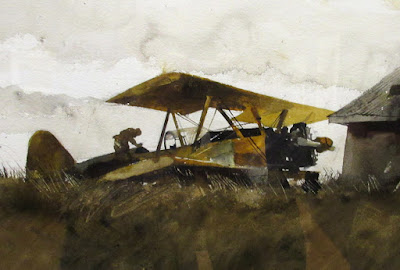 |
| Andrew Wyeth, Rockland Harbor, 1954 |
 |
| Wyeth, detail of Harjula's Airport, 1964 |
Wyeth takes great care in drawing and perspective, but he's very selective, focusing only on the part of the scene he wants to show. This biplane is only a small area of the overall composition, and it is carefully observed but efficiently described.
Here's a detail of "The Slip," showing a two-masted schooner in dry dock, surrounded by grass. The painting is listed as a "drybrush watercolor," a term popularized by the Wyeths to include some opaque white gouache passages. The term is a little misleading, because the pigment isn't necessarily applied dry.

There's also an exhibition called NC Wyeth: Poems of American Patriotism at the nearby Wyeth Center, part of the Farnsworth Art Museum.
-----
Museum website: Andrew Wyeth in Rockland through February 17, 2019.
Online article: Andrew Wyeth's Rockland: Boats, Planes, and Trains
Recommended books:
Andrew Wyeth: Looking Out, Looking In
Andrew Wyeth: A Secret Life
Andrew Wyeth, Christina's World, and the Olson House
Andrew Wyeth: A Spoken Self-Portrait








9 comments:
Never seen these beauties before, wow!
Lucky you--I have seen some Wyeths (including a Helga exhibition of late works), but his early watercolors are of special interest to me. I have read that he became mistrustful of his own facility in watercolor (and at such an early age) that it in part led him to the slow and rigorous medium of egg tempera and drybrush watercolor.
Scott, yeah, Wyeth was very personal and secretive about his technique. The way it strikes me, he had these two contrary impulses: one was wild and loose and out of control, and the other was precise and controlled and patient. So many of his watercolors are a tug of war between these two impulses.
I've read the term "dry brush" so often, I'm glad you addressed it. Apparently the term is waaaay misleading. If you would elaborate, I'd appreciate it. While I rarely use water media, and then only acrylic, I've always wondered....
Not sure that his "drybrush" refers to white gouache only. From looking at some of the paintings closely "in person", it does seem to me that he combined gouache (not sure about white only but maybe) and watercolor, not unlike what Nathan Fowkes is doing. Some of the large washes have kind of a murky milky consistency to them that I don't know how to achieve with watercolor only. There are also streaks of white gouache for highlights (such is the netting in the painting of a young bull. Paradoxically, in Wyeth's paintings there are rarely passages of what we actually associate with drybrush nowadays, that is the broken, textured strokes employed by many contemporary watercolorists (John Yardley, for example, is a great master of this). And I am still at loss how exactly he created most of his paintings that are classified as "drybrush". He says he was squeezing the paint out of the brush with his fingers but I don't think this adequately explains the remarkable results. I also think he used ink quite a bit for some of the very dark washes (for sure in "The German", as he himself said so, but also in a bunch of other paintings, such as "Lovers")
Peter, you're right: "drybrush" was a very personal term for Wyeth, and tied to his emotions. He talks about it in detail in the interview with Thomas Hoving in the book "The Two Worlds of Andrew Wyeth." I'll do a post about his use of the term in the future.
Also, the Wyeth episode of American Masters is streamable from on the PBS site: https://www.pbs.org/video/andrew-wyeth-1bzyzm/
I had the privilege of regularly looking at Andrew Wythe's work during the 70s and 80s when the Greenville Museum of Art (SC) had a large collection on exhibit. I remember the collection drew international attention to this small city. I took art classes there every summer and spent a lot of time in the gallery where the collection was housed. Truly amazing work.
Thank you for explaining a bit about what Wyeth meant by "drybrush". I've been an admirer of A. Wyeth's work since a teen, but that term always left me wondering. Now that I'm rediscovering watercolour and trying gouache for the first time other than just white (M. Graham), it's nice to know a bit more about that technique. Looking forward to hearing more if you choose to post further on it.
Post a Comment